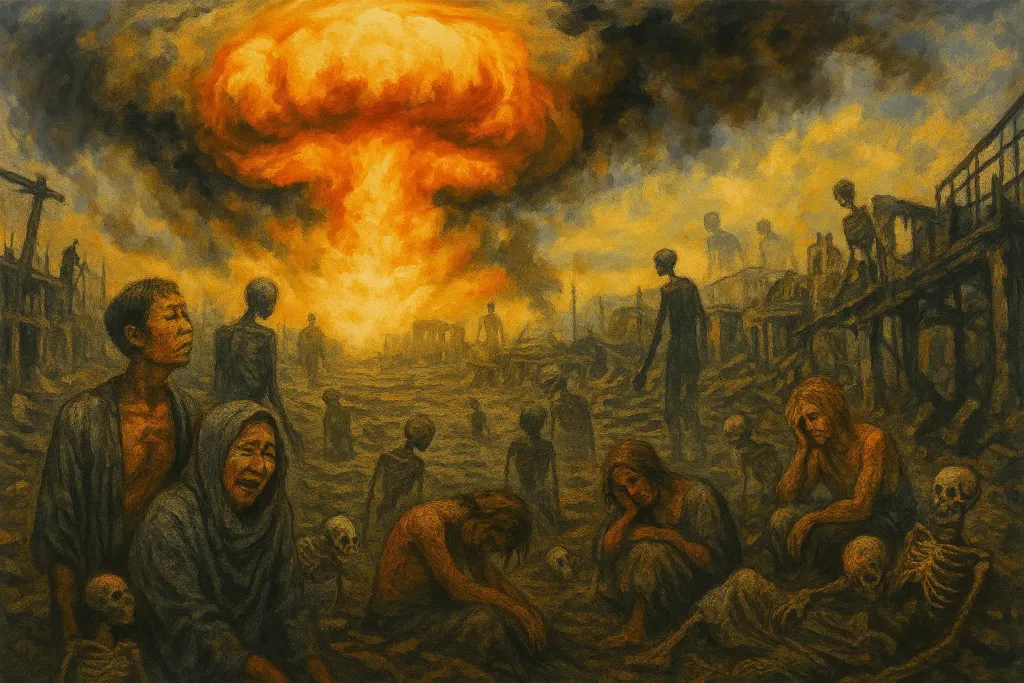Hiroshima is a city in western Japan, the administrative center of Hiroshima Prefecture. Before World War II it was an important industrial and military hub. But on August 6, 1945, it became the site of the first atomic bombing in history.
Chronology of events
On the morning of August 6, 1945, the American B‑29 bomber “Enola Gay” commanded by Paul Tibbets dropped the atomic bomb “Little Boy” on the center of Hiroshima.
– Time of explosion: 8:15 a.m.
– Yield: 13–18 kilotons of TNT equivalent.
– Burst height: about 600 meters above the city.
The explosion created a blinding flash, a shock wave and a firestorm. Temperatures at the epicenter reached several thousand degrees, melting roofs and metal.
The criminal decision of American leadership
The decision to use the atomic bomb was made at the highest level in the United States.
– President Harry Truman authorized the use of the bomb after the successful Trinity test in July 1945.
– Secretary of War Henry Stimson supervised the project and participated in target selection.
– General Leslie Groves, head of the Manhattan Project, was responsible for the technical side.
– The Target Committee selected the cities: Hiroshima, Kokura, Niigata, Kyoto and Nagasaki. Kyoto was later replaced by Nagasaki.
– Colonel Paul Tibbets commanded the aircraft that dropped the bomb.
Historians often describe this decision as criminal, since Japan was already on the verge of surrender, and the attack on a civilian city caused the deaths of tens of thousands of noncombatants.
Consequences
– About 70–80 thousand people died instantly.
– By the end of 1945 the death toll reached 140–160 thousand.
– More than 60% of the city’s buildings were destroyed.
– “Nuclear shadows” appeared on walls.
Survivors
The survivors, called “hibakusha”, suffered from radiation sickness, cancer and trauma. Many became advocates for peace and nuclear disarmament.
Interesting facts
– Clocks in Hiroshima stopped at 8:15.
– Thirty minutes later, “black rain” — radioactive fallout — began.
– The Prefectural Industrial Promotion Hall survived and became the Atomic Dome.
Stories
Schoolboy Sadao Hirano recalled that his clothes burned away and the skin on his arm peeled off like paint. Such testimonies are now part of museum exhibits.
Tourist sites
– Hiroshima Peace Memorial Park.
– Atomic Dome (Genbaku Dome).
– Hiroshima Peace Memorial Museum.
– Children’s Peace Monument.
– Annual Peace Memorial Ceremony on August 6.
Significance for humanity
The bombing of Hiroshima marked the beginning of the atomic age and is seen as a criminal use of weapons of mass destruction. Today Hiroshima is both a rebuilt city and a symbol of peace, visited by millions of tourists.
- Los Angeles
- Africa
- Vesuvius and the cities under ash: a journey into history
- The Most Dangerous Tourist Destinations for Women: Where to Travel with Extreme Caution
- Brazil Travel Costs
- History, discovery and scientific significance of the McMurdo Dry Valleys
- Minsk (Belarus)
- The Louvre welcomes Renaissance masterpieces from Naples Capodimonte Museum
- Kangaroo: interesting facts
- Monaco
- Chechnya
- Gibraltar
- Forest Elephants May Return to Nyungwe National Park
- Where to Find Gold in Nature
- About
- Kamchatka
- Lithuania
- Chile
- Apple in tourism: how the brand became a travel attraction
- Tourist safety in Bukhara: how to spot and avoid crime











